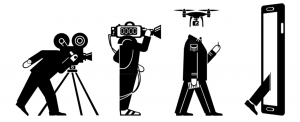One of the aims of the Harun Farocki Institut is to support archival activities, chiefly concerning Farocki’s personal and professional archival materials, but also to the critical study of moving images at large. In this spirit, I’ve spent some of my time in my residency undergoing a personal archival project, uploading and cataloging all of the 300+ video essays I’ve produced over the last ten years to my Vimeo account and linked to my personal website. So far I’m a third of the way through this project.
As I go through this cataloging process, I think about how to make these videos most useful and accessible to anyone who happens to encounter them. I’ve tagged each video with keywords corresponding to the historical period of their subject (i.e. 1920s for a late silent era film), as well as genre, geographical or national origin, or filmmaking topic (e.g. acting and performance; cinematography). Part of this is to diagnose what my own prevailing topical interests have been over the last ten years: how many video essays have I made about editing as opposed to narrative structure, cinematography or acting?
For now, it seems the most useful way to present the works on this blog is by chronology. I’ll be posting entries with links to Vimeo album collections for each of the last ten years that I have been making video essays.
Here is the album of video essays I produced in 2007.
I produced my first video essay on April 25, 2007, on the film While The City Sleeps by Fritz Lang. I ended up producing 17 video essays for that year. The most popular one, based on combined YouTube and Vimeo views, is this one that I made for Evil Dead 2. In this period I was experimenting with a combination of footage that I shot myself with footage from the film, as a way of creating a dialogue between these modes of film study: found footage vs. original footage. Somehow I abandoned this approach in subsequent years, though whenever it did make a rare appearance it made for a memorable result, so this may be a technique worth taking less for granted from now on.
I was particularly happy with my use of original footage in this video essay on the film …And God Created Woman, where I filmed Brigitte Bardot playing as a reflection on my glasses, creating a visual comment on the spectatorship of the female subject, the main theme of the video essay.
But I think my favorite video that I produced in 2007 is this, comparing the films The Vanishing and David Fincher’s Zodiac. It’s startling to hear my own voice at this time, mumbling, stumbling and unpolished in its delivery. It’s the kind of awkward film nerd voice that Cameron Carpenter and Kentucker Audley mimic in their own video essay parodies. Truth be told, I was on antidepressants at the time and not feeling terribly satisfied about my life as a filmmaker or critic, and I was just trying to find a way forward. I think the qualities of this stumbling search are reflected in my voice. Making these videos seemed like the most promising direction to make my efforts make sense to myself.
I like how the shots of myself editing the video essay alongside my dog don’t really explain what they are doing. Maybe I wasn’t entirely clear myself as to what I was doing, other than a vague intuition about the possible connections between the human endeavors depicted in these two films and that of myself on my desktop and my dog (Leila, 2003-2013) with her chew cone. It’s about a certain kind of fulfillment derived from losing oneself in a deeply immersive activity, which for me happened to be the production of video essays.
It is this immersion in one’s work that I have been provoked to question so far this year, through the new perspective and life rhythms afforded by the residency, the major disruption to my work that led me to quit my position at Fandor after seven productive years (more on this sometime soon), and even reflecting on such remarkable thinkers as Thomas Elsaesser and Alain Bergala, and their stated relationships not just to the study of film, but to the value of one’s work and the stakes of producing a legacy. These are questions I continue to think about as I use this time to plot, yet again, the best way forward.
